Related Research Articles
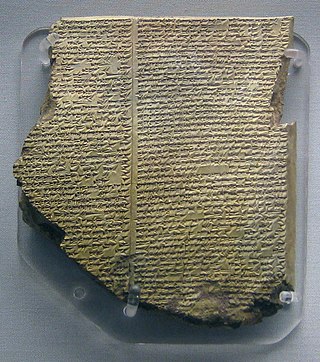
An epic poem, or simply an epic, is a lengthy narrative poem typically about the extraordinary deeds of extraordinary characters who, in dealings with gods or other superhuman forces, gave shape to the mortal universe for their descendants.
Old English literature refers to poetry and prose written in Old English in early medieval England, from the 7th century to the decades after the Norman Conquest of 1066, a period often termed Anglo-Saxon England. The 7th-century work Cædmon's Hymn is often considered as the oldest surviving poem in English, as it appears in an 8th-century copy of Bede's text, the Ecclesiastical History of the English People. Poetry written in the mid 12th century represents some of the latest post-Norman examples of Old English. Adherence to the grammatical rules of Old English is largely inconsistent in 12th-century work, and by the 13th century the grammar and syntax of Old English had almost completely deteriorated, giving way to the much larger Middle English corpus of literature.

Poetry is a form of literary art that uses aesthetic and often rhythmic qualities of language to evoke meanings in addition to, or in place of, literal or surface-level meanings. Any particular instance of poetry is called a poem and is written by a poet. Poets use a variety of techniques called poetic devices, such as assonance, alliteration, euphony and cacophony, onomatopoeia, rhythm, and sound symbolism, to produce musical or incantatory effects. Most poems are formatted in verse: a series or stack of lines on a page, which follow a rhythmic or other deliberate pattern. For this reason, verse has also become a synonym for poetry.
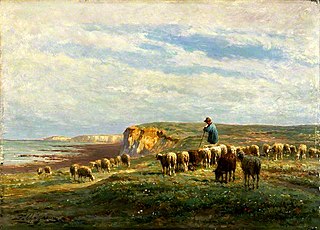
A villanelle, also known as villanesque, is a nineteen-line poetic form consisting of five tercets followed by a quatrain. There are two refrains and two repeating rhymes, with the first and third lines of the first tercet repeated alternately at the end of each subsequent stanza until the last stanza, which includes both repeated lines. The villanelle is an example of a fixed verse form. The word derives from Latin, then Italian, and is related to the initial subject of the form being the pastoral.
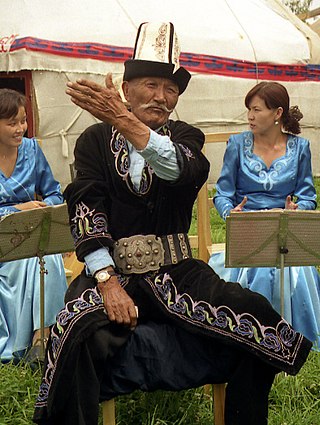
Oral tradition, or oral lore, is a form of human communication wherein knowledge, art, ideas and cultural material is received, preserved, and transmitted orally from one generation to another. The transmission is through speech or song and may include folktales, ballads, chants, prose or poetry. In this way, it is possible for a society to transmit oral history, oral literature, oral law and other knowledge across generations without a writing system, or in parallel to a writing system. Religions such as Buddhism, Hinduism, Catholicism, and Jainism, for example, have used an oral tradition, in parallel to a writing system, to transmit their canonical scriptures, rituals, hymns and mythologies from one generation to the next. Sub-Saharan African societies have broadly been labelled as "oral civilisations", contrasted with "literate civilisations", due to their reverence for the spoken word and the important place it has in their cultures.
Assonance is the repetition of identical or similar phonemes in words or syllables that occur close together, either in terms of their vowel phonemes or their consonant phonemes. However, in American usage, assonance exclusively refers to this phenomenon when affecting vowels, whereas, when affecting consonants, it is generally called consonance. The two types are often combined, as between the words six and switch, which contain the same vowel and similar consonants. If there is repetition of the same vowel or some similar vowels in literary work, especially in stressed syllables, this may be termed "vowel harmony" in poetry.
Consonance is a stylistic literary device identified by the repetition of identical or similar consonants in neighboring words whose vowel sounds are different. Consonance may be regarded as the counterpart to the vowel-sound repetition known as assonance.

The Song of Roland is an 11th-century chanson de geste based on the deeds of the Frankish military leader Roland at the Battle of Roncevaux Pass in AD 778, during the reign of the Emperor Charlemagne. It is the oldest surviving major work of French literature. It exists in various manuscript versions, which testify to its enormous and enduring popularity in Medieval and Renaissance literature from the 12th to 16th centuries.

The chanson de geste is a medieval narrative, a type of epic poem that appears at the dawn of French literature. The earliest known poems of this genre date from the late 11th and early 12th centuries, shortly before the emergence of the lyric poetry of the troubadours and trouvères, and the earliest verse romances. They reached their highest point of acceptance in the period 1150–1250.
A virelai is a form of medieval French verse used often in poetry and music. It is one of the three formes fixes and was one of the most common verse forms set to music in Europe from the late thirteenth to the fifteenth centuries.
A rondeau is a form of medieval and Renaissance French poetry, as well as the corresponding musical chanson form. Together with the ballade and the virelai it was considered one of three formes fixes, and one of the verse forms in France most commonly set to music between the late 13th and the 15th centuries. It is structured around a fixed pattern of repetition of verse with a refrain. The rondeau is believed to have originated in dance songs involving singing of the refrain by a group alternating with the other lines by a soloist. The term "Rondeau" is used both in a wider sense, covering older styles of the form which are sometimes distinguished as the triolet and rondel, and in a narrower sense referring to a 15-line style which developed from these forms in the 15th and 16th centuries. The rondeau is unrelated to the much later instrumental dance form that shares the same name in French baroque music, which is more commonly called the rondo form in classical music.

Medieval French literature is, for the purpose of this article, Medieval literature written in Oïl languages during the period from the eleventh century to the end of the fifteenth century.

Oliver, sometimes referred to as Olivier de Vienne or de Gennes, is a legendary knight in the Matter of France chansons de geste, especially the French epic The Song of Roland. In the tradition, he was Roland's closest friend, advisor, confidant and brother-in-law to be, one of Charlemagne's twelve peers and brother of Aude, Roland's betrothed. He dies with Roland at the Battle of Roncevaux Pass. Some critics have linked his name to the olive tree, a biblical symbol of divine wisdom.
Raoul de Cambrai is a 12th -13th century French epic poem concerning the eponymous hero's battles to take possession of his fief and of the repercussions from these battles. It is typically grouped in the "rebellious vassals cycle", or "Geste of Doon de Mayence".

The Homeric Question concerns the doubts and consequent debate over the identity of Homer, the authorship of the Iliad and Odyssey, and their historicity. The subject has its roots in classical antiquity and the scholarship of the Hellenistic period, but has flourished among Homeric scholars of the 19th, 20th, and 21st centuries.
This is a glossary of poetry terms.
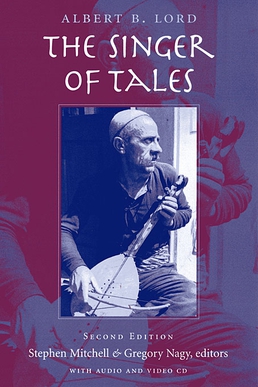
The Singer of Tales is a book by Albert Lord that discusses the oral tradition as a theory of literary composition and its applications to Homeric and medieval epic. Lord builds on the research of Milman Parry and their work together recording Balkan guslar poets. It was published in 1960.
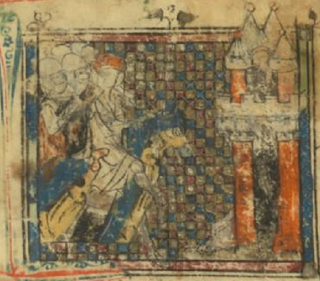
Aymeri de Narbonne is a legendary hero of Old French chansons de geste and the Matter of France. In the legendary material, as elaborated and expanded in various medieval texts, Aymeri is a knight in the time of Charlemagne's wars with the Saracens after the Battle of Roncevaux Pass. He is son of Hernaut and the grandson of Garin de Monglane. He conquers the city of Narbonne, marries a princess named Hermengarde or Hermenjart, and fathers seven sons, the most famous being Guillaume d'Orange, the hero of several popular chansons de geste.

Prise d'Orange is a mid-12th century chanson de geste written in Old French. Its fictional story follows the hero Guillaume as he captures the walled city of Orange from Saracens and marries Orable, its queen. Other characters include Arragon, the king of Orange, and Tibaut, Orable's erstwhile husband and Arragon's father. The anonymously written poem, part of a larger cycle about Guillaume called La Geste de Garin de Monglane, consists of 1,888 decasyllable verses in laisses. It combines motifs of courtly love with an epic story of military conquest. The narrative is humorous and parodies the tropes of epic poetry.

Cædmon's Hymn is a short Old English poem attributed to Cædmon, a supposedly illiterate and unmusical cow-herder who was, according to the Northumbrian monk Bede, miraculously empowered to sing in honour of God the Creator. The poem is Cædmon's only known composition.
References
- Princeton Encyclopedia of Poetry and Poetics. Alex Preminger, ed. Princeton: Princeton University Press, 1965, 1974. "Laisse", p. 436.
- Gerard J. Brault, ed. The Song of Roland: An Analytical Edition. (Pennsylvania State University, 1978). ISBN 0-271-00516-5